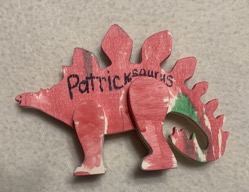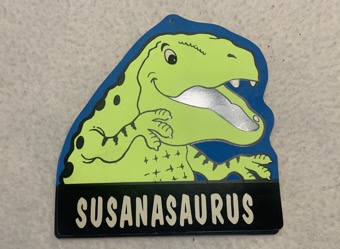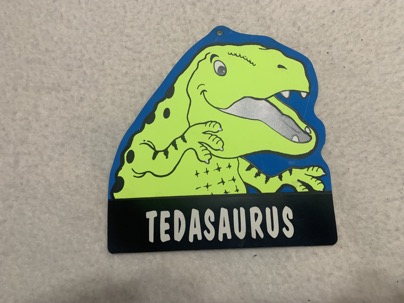Thinking of Dinosaurs
27/01/23 02:01
These days I frequently find myself in a place where I am one of the oldest persons in attendance. I invested a few hours of the past week in a meeting of a board made up of other faith formation professionals. I consider them to be my colleagues. At one point, however, I realized that I was the oldest person at the meeting. Normally it doesn’t bother me. I frequently say that I have never been the right age for anything. I went straight from being too young to being too old. When I am serious about it, however, I haven’t experienced any real age discrimination. I was allowed to pursue my education and hold student jobs when I was younger than most of my classmates. I married younger than most of my peers. And I have been allowed to work in a meaningful job even though many colleagues my age are fully retired.
The span of a human life is short when compared to some known timelines. I’ve know a lot of children who are fascinated with dinosaurs. They will tell me about the different periods in which dinosaurs lived: Triassic, Jurassic, and Cretaceous. I know an eight-year-old who can give you rough dates for the times in which dinosaurs lived. Did you know that the span of time in which Stegosaurus lived (150 to 130 million years ago) is farther away from the time when Tyrannosaurus rex livd (80 to 65 million years ago) than the difference between Tyrannosaurus rex and the first humans (300,000 to 200,000) years ago? It is true. I looked it up, but I first learned that fact from someone who I’m pretty sure has no idea what it means to be 21 years old, let alone 70.
 Our three-year-old grandson encounters information about dinosaurs in books, television programs, the Internet, and through conversations with other children. We have accepted that children have a fascination with dinosaurs and we encourage it by helping them find information. One of his craft projects was painting a wooden toy dinosaur with spines on its back and tail. An adult put his name on it and then added “saurus” to the end of his name. As far as I know there is no archaeological evidence of any creature that has been called “Patricksaurus,” but it was a project that entertained our grandson for a while. He presented the wooden toy to us as a gift.
Our three-year-old grandson encounters information about dinosaurs in books, television programs, the Internet, and through conversations with other children. We have accepted that children have a fascination with dinosaurs and we encourage it by helping them find information. One of his craft projects was painting a wooden toy dinosaur with spines on its back and tail. An adult put his name on it and then added “saurus” to the end of his name. As far as I know there is no archaeological evidence of any creature that has been called “Patricksaurus,” but it was a project that entertained our grandson for a while. He presented the wooden toy to us as a gift.
 The gift reminded Susan and me of other gifts we received many years ago. One of the children in a church that we served presented us with cardboard ornaments that had pictures of dinosaur-like creatures and our names modified to label the creatures. One said Susanasaurus, the other Tedasaurus. I’m not sure why we have kept those simple ornaments for so many years. Susan had hers displayed in her office for a long time. Mine had been stuck in a pile of unsorted papers and only recently emerged as we continue the process of sorting and getting rid of excess items we have kept for many years. I have no idea why we kept those cardboard trinkets. A sensible person would have discarded them before we moved from South Dakota. Then again, a sensible person would have disposed of them years ago. No one ever accused me of being sensible, however, so we have the three pretend items together in our bedroom for now. At some point we’ll recycle them. You can’t keep everything. I can’t imagine us taking such things to display in a nursing home room.
The gift reminded Susan and me of other gifts we received many years ago. One of the children in a church that we served presented us with cardboard ornaments that had pictures of dinosaur-like creatures and our names modified to label the creatures. One said Susanasaurus, the other Tedasaurus. I’m not sure why we have kept those simple ornaments for so many years. Susan had hers displayed in her office for a long time. Mine had been stuck in a pile of unsorted papers and only recently emerged as we continue the process of sorting and getting rid of excess items we have kept for many years. I have no idea why we kept those cardboard trinkets. A sensible person would have discarded them before we moved from South Dakota. Then again, a sensible person would have disposed of them years ago. No one ever accused me of being sensible, however, so we have the three pretend items together in our bedroom for now. At some point we’ll recycle them. You can’t keep everything. I can’t imagine us taking such things to display in a nursing home room.
 Silliness and stories aside, it is interesting to me that our imaginations allow us to travel millions of years into the past while most of us can’t or don’t imagine what the world will be like even a few decades into the future. We choose not to think much about what the world will be like after we have died.
Silliness and stories aside, it is interesting to me that our imaginations allow us to travel millions of years into the past while most of us can’t or don’t imagine what the world will be like even a few decades into the future. We choose not to think much about what the world will be like after we have died.
The quirky movie about time travel, “Back to the Future,” and sequels, tell a story of Marty McFly, a teenager in 1985, being accidentally sent back to 1955. Later, McFly and Doc Brown travel ahead in time to 2015. The depiction of 1955 in the movie was more accurate than the depiction of 2015. We still don’t have functional hoverboards and it is 2023. One of the things about that particular movie is that the span of time travel was shorter than the span of my life. I was a toddler in 1955, the father of a toddler in 1985, and the grandfather of a toddler tin 2015. And I’m still around.
In one story, 60 years is treated like a long span of time. In another story, we are invited to think about what life was like 150 million years ago. Our brains make the adjustment from story to story without being fully aware of the incredible differences in the amount of time.
While it is fun and interesting to think about different spans of time, we have now come to a point in human history where we need to get serious about our future and make changes in the present that don’t precipitate human extinction. Three days ago, the Bulletin of Atomic Scientists unveiled the current doomsday clock. The hands are at their closest to midnight ever, now only 90 seconds: one minute and a half out of 24 hours. It is supposed to be a wake-up call about how close we are to destroying all of humanity with dangerous technologies and misguided policies.
Just as the age of dinosaurs came to an end, it seems likely that the age of humans will also come to an end at some point. I wonder what will come next. It makes me think about what we leave behind after we are gone. Will our legacy be brilliant ideas and incredible inventions? Will we leave behind a history of life on this planet, or will our time be forgotten. Will the incredible knowledge of libraries and the Internet remain or be lost? Somehow I can imagine some future life form sifting through the remains of human civilization trying to imagine what our lives were like. They come across the remains of three representations of dinosaurs with strange words on them: Patricksaurus, Susansaurus, and Tedsaurus.
The span of a human life is short when compared to some known timelines. I’ve know a lot of children who are fascinated with dinosaurs. They will tell me about the different periods in which dinosaurs lived: Triassic, Jurassic, and Cretaceous. I know an eight-year-old who can give you rough dates for the times in which dinosaurs lived. Did you know that the span of time in which Stegosaurus lived (150 to 130 million years ago) is farther away from the time when Tyrannosaurus rex livd (80 to 65 million years ago) than the difference between Tyrannosaurus rex and the first humans (300,000 to 200,000) years ago? It is true. I looked it up, but I first learned that fact from someone who I’m pretty sure has no idea what it means to be 21 years old, let alone 70.



The quirky movie about time travel, “Back to the Future,” and sequels, tell a story of Marty McFly, a teenager in 1985, being accidentally sent back to 1955. Later, McFly and Doc Brown travel ahead in time to 2015. The depiction of 1955 in the movie was more accurate than the depiction of 2015. We still don’t have functional hoverboards and it is 2023. One of the things about that particular movie is that the span of time travel was shorter than the span of my life. I was a toddler in 1955, the father of a toddler in 1985, and the grandfather of a toddler tin 2015. And I’m still around.
In one story, 60 years is treated like a long span of time. In another story, we are invited to think about what life was like 150 million years ago. Our brains make the adjustment from story to story without being fully aware of the incredible differences in the amount of time.
While it is fun and interesting to think about different spans of time, we have now come to a point in human history where we need to get serious about our future and make changes in the present that don’t precipitate human extinction. Three days ago, the Bulletin of Atomic Scientists unveiled the current doomsday clock. The hands are at their closest to midnight ever, now only 90 seconds: one minute and a half out of 24 hours. It is supposed to be a wake-up call about how close we are to destroying all of humanity with dangerous technologies and misguided policies.
Just as the age of dinosaurs came to an end, it seems likely that the age of humans will also come to an end at some point. I wonder what will come next. It makes me think about what we leave behind after we are gone. Will our legacy be brilliant ideas and incredible inventions? Will we leave behind a history of life on this planet, or will our time be forgotten. Will the incredible knowledge of libraries and the Internet remain or be lost? Somehow I can imagine some future life form sifting through the remains of human civilization trying to imagine what our lives were like. They come across the remains of three representations of dinosaurs with strange words on them: Patricksaurus, Susansaurus, and Tedsaurus.
